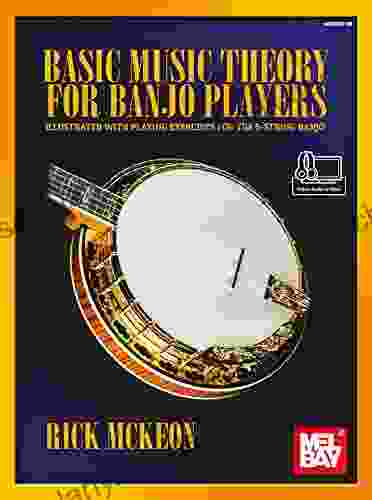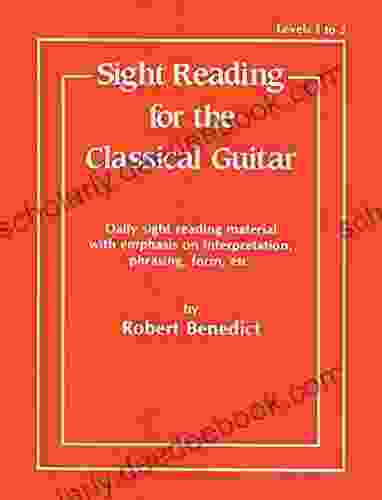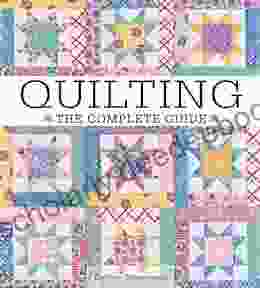Basic Music Theory for Banjo Players

Banjo players, like musicians of all stripes, can benefit greatly from a solid understanding of music theory. Theory is a collection of organizing principles that underpin the music we hear, and it can help us improve our playing in a number of ways, from interpreting chord charts to improvising solos.
4.5 out of 5
| Language | : | English |
| File size | : | 35241 KB |
| Screen Reader | : | Supported |
| Print length | : | 161 pages |
In this guide, we'll cover the following topics:
* Intervals * Scales * Chord Progressions
By the end of this guide, you'll have a firm grasp of the basics of music theory, and you'll be able to use this knowledge to improve your playing.
Intervals
An interval describes the distance between any two musical notes. Intervals are measured in half steps, with each half step representing a single fret on the banjo neck. The smallest interval is the unison (0 half steps),which is when two notes are the same pitch. The largest interval is the octave (12 half steps),which is when two notes are an octave apart.
Intervals can be described as either consonant or dissonant. Consonant intervals sound pleasing to the ear, while dissonant intervals sound more tense. Consonant intervals include the unison, octave, perfect fifth, and major third. Dissonant intervals include the minor second, tritones, and augmented fourth.
Intervals are used to build chords and scales, and they can also be used to create melodies. By understanding intervals, you can learn to play more complex and interesting music.
Scales
A scale is a series of notes arranged in ascending or descending order. Scales are used to create melodies and solos, and they can also be used to accompany chords. Each scale contains seven notes, and each note is separated by an interval. There are many different types of scales, and each one has a unique sound. The most common scales in banjo music are the major scale, the minor scale, the pentatonic scale, and the blues scale.
The major scale is a bright and cheerful scale. It is made up of the following intervals: 1, 2, 3, 4, 5, 6, and 7. The minor scale is a darker and more somber scale. It is made up of the following intervals: 1, 2, b3, 4, 5, b6, and b7. The pentatonic scale is a five-note scale that is often used in folk and blues music. It is made up of the following intervals: 1, 2, 3, 5, and 6. The blues scale is a seven-note scale that is often used in blues music. It is made up of the following intervals: 1, b3, 4, b5, 5, b7, and 1.
Scales are a great way to improve your banjo playing. By practicing scales, you can improve your finger dexterity, your pitch accuracy, and your overall musicality.
Chord Progressions
A chord progression is a series of chords played in a specific order. Chord progressions are used to create harmony and movement in a piece of music. The most common chord progression in banjo music is the I-IV-V progression, which is made up of the following chords: I (the root chord),IV (the subdominant chord),and V (the dominant chord).
Other common chord progressions include the I-V-IV progression, the III-VI-II-V progression, and the II-V-I progression. Chord progressions can be used to create a variety of different moods and emotions in a piece of music. By understanding chord progressions, you can learn to write and play more complex and interesting music.
Music theory is a powerful tool that can help you improve your banjo playing at any level. By understanding intervals, scales, and chord progressions, you can learn to play more complex and interesting music. So what are you waiting for? Start learning music theory today!
4.5 out of 5
| Language | : | English |
| File size | : | 35241 KB |
| Screen Reader | : | Supported |
| Print length | : | 161 pages |
Do you want to contribute by writing guest posts on this blog?
Please contact us and send us a resume of previous articles that you have written.
 Book
Book Novel
Novel Page
Page Text
Text Story
Story Reader
Reader Paperback
Paperback Newspaper
Newspaper Paragraph
Paragraph Bookmark
Bookmark Shelf
Shelf Glossary
Glossary Preface
Preface Synopsis
Synopsis Footnote
Footnote Manuscript
Manuscript Scroll
Scroll Tome
Tome Bestseller
Bestseller Classics
Classics Narrative
Narrative Autobiography
Autobiography Encyclopedia
Encyclopedia Thesaurus
Thesaurus Narrator
Narrator Character
Character Catalog
Catalog Card Catalog
Card Catalog Borrowing
Borrowing Stacks
Stacks Archives
Archives Periodicals
Periodicals Academic
Academic Journals
Journals Reading Room
Reading Room Rare Books
Rare Books Interlibrary
Interlibrary Study Group
Study Group Reading List
Reading List Textbooks
Textbooks Reagan Tunstall
Reagan Tunstall Vesna Maric
Vesna Maric M R Nelson
M R Nelson Elayne Audrey Becker
Elayne Audrey Becker D Stephenson Bond
D Stephenson Bond Millz O Day
Millz O Day Susanna Fogel
Susanna Fogel Andy Bennett
Andy Bennett Alan Siaroff
Alan Siaroff Josef Falkinger
Josef Falkinger Paul Kupperberg
Paul Kupperberg Joelle Richa
Joelle Richa Joanna Toye
Joanna Toye Sherri Duskey Rinker
Sherri Duskey Rinker Stephen Tankel
Stephen Tankel Julia Bourne
Julia Bourne Stephen Walsh
Stephen Walsh Ronald Malfi
Ronald Malfi S J Watson
S J Watson Laurel A Rockefeller
Laurel A Rockefeller
Light bulbAdvertise smarter! Our strategic ad space ensures maximum exposure. Reserve your spot today!

 Stephen KingDream Theater's "Awake" Awake Authentic Guitar Tab Edition: A Comprehensive...
Stephen KingDream Theater's "Awake" Awake Authentic Guitar Tab Edition: A Comprehensive... Ismael HayesFollow ·6.2k
Ismael HayesFollow ·6.2k Isaac BellFollow ·18k
Isaac BellFollow ·18k Lawrence BellFollow ·4.2k
Lawrence BellFollow ·4.2k Federico García LorcaFollow ·3k
Federico García LorcaFollow ·3k Bobby HowardFollow ·3.1k
Bobby HowardFollow ·3.1k Shaun NelsonFollow ·5.9k
Shaun NelsonFollow ·5.9k E.E. CummingsFollow ·8.4k
E.E. CummingsFollow ·8.4k Brenton CoxFollow ·8.5k
Brenton CoxFollow ·8.5k

 Houston Powell
Houston PowellMusorgsky and His Circle: A Russian Musical Revolution
Modest Mussorgsky was a Russian...
 Barry Bryant
Barry BryantRanking the 80s with Bill Carroll: A Nostalgic Journey...
Prepare to embark on a captivating...

 Kelly Blair
Kelly BlairThe Diplomat's Travel Guide to Festivals, Holidays, and...
India is a land of vibrant culture and...

 José Saramago
José SaramagoFancy Nancy Nancy Clancy: Late-Breaking News!
Nancy Clancy is back with all-new adventures...

 Trevor Bell
Trevor BellGestalt Psychotherapy and Coaching for Relationships: A...
Relationships...

 Federico García Lorca
Federico García LorcaThe Last Love of George Sand: An Enduring Legacy of...
At the twilight of her remarkable life,...
4.5 out of 5
| Language | : | English |
| File size | : | 35241 KB |
| Screen Reader | : | Supported |
| Print length | : | 161 pages |










